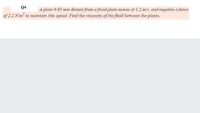
Elements Of Electromagnetics
7th Edition
ISBN: 9780190698614
Author: Sadiku, Matthew N. O.
Publisher: Oxford University Press
expand_more
expand_more
format_list_bulleted
Concept explainers
Question

Transcribed Image Text:Q4
A plate 0.05 mm distant from a fixed plate moves at 1.2 m/s ad requires a force
of 2.2 N/m to maintain this speed. Find the viscosity of the fluid between the plates.
Expert Solution
This question has been solved!
Explore an expertly crafted, step-by-step solution for a thorough understanding of key concepts.
This is a popular solution
Trending nowThis is a popular solution!
Step by stepSolved in 2 steps

Knowledge Booster
Learn more about
Need a deep-dive on the concept behind this application? Look no further. Learn more about this topic, mechanical-engineering and related others by exploring similar questions and additional content below.Similar questions
- A2 A Newtonian fluid with viscosity (Mu) flows upward at a steady rate between two parallel plates that make an angle y with the horizontal. The fluid thickness h is much smaller than the width of the channel W. The pressures at each end, P(0) and P(L), are known and the pressure variations in the y-direction are small. Assume that Vy and Vz = 0 and Vx is a function of y alone. Use the shell balance to approach : - the Total flowrate, QVarrow_forwardIf a stream flowing at velocity U past a body of lengthL causes a force F on the body that depends only on U , L ,and fluid viscosity μ , then F must be proportional to(a) ρUL/μ, (b) ρU2L2, (c) μU/L, (d) μUL, (e) UL/μarrow_forwardThe device in Fig. is called a cone-plate viscometer. The angle of the cone is very small, so that sin θ ≈ θ ,and the gap is fi lled with the test liquid. The torque M torotate the cone at a rate V is measured. Assuming a linearvelocity profi le in the fl uid fi lm, derive an expression forfl uid viscosity μ as a function of ( M , R , V , θ ).arrow_forward
- (Just Question a.) A water filled pipe has water flowing at v1= 5.90 m/s in a section of pipe where the diameter is d1= 20.2 cm and the pressure is known to be P1= 7.00×104 N/m2 above atmospheric pressure. If the pipe carries the water 3.5 meters up hill without any change in diameter, what is the new absolute pressure within the pipe? After flowing up the hill described above, the pipe narrows to 80% of its original radius, what will be the new water velocity (v2) in the pipe? What will be the absolute pressure (P3) in the smaller pipe? a. What is the volume flow rate through the smaller pipe?arrow_forwardA plate 0.05mm distance from a fixed plate moves at 1.25 m/s and required a force per unit area of 3 Pa to maintain this speed by using an oil of specific gravity 0.65. Find the dynamic viscosity in centipoise and kinematic viscosity in stokes of the fluid between the plates. Calculate the specific weight in kN/m³, density, and the specific gravity of a liquid having a volume of 662900 cm and weight of 55 kNarrow_forwardI am working on practice problems and am stuck on this question.arrow_forward
- A cylindrical machine part moves within a surrounding cylinder. The centrelines of the part and the surrounding cylinder are coincident. The cylinder is full of an oil (viscosity 0.25kg/ms) that is not flowing i.e. no pressure gradient is applied. What is the value of the viscous force exerted on the machine part as it moves along the cylinder at a speed of 9m/s? • The machine part is 0.06m long and has a radius of 0.041m. • The ratio of the machine part radius to the cylinder radius is 0.98. • Assume that the flow is dominated by viscous forces. • Give your answer as an absolute value i.e. no negative sign, in Newtons to one decimal place.arrow_forwardI would really appreciate it if you could tell me how to solve the problem.arrow_forwardConsider (Figure 1). The cord is attached to the 36-lb block, and the coefficients of static friction are HB = 0.2 and μp = 0.3. Figure M 1.5 ft B 3 ft -1.5 ft- D C < 1 of 1 Part A Determine the smallest couple moment which can be applied to the 24-lb wheel that will cause impending motion. Express your answer in pound-feet to three significant figures. VAΣo↓↑ vec M = Submit Provide Feedback Request Answer A ? lb-ftarrow_forward
arrow_back_ios
arrow_forward_ios
Recommended textbooks for you
 Elements Of ElectromagneticsMechanical EngineeringISBN:9780190698614Author:Sadiku, Matthew N. O.Publisher:Oxford University Press
Elements Of ElectromagneticsMechanical EngineeringISBN:9780190698614Author:Sadiku, Matthew N. O.Publisher:Oxford University Press Mechanics of Materials (10th Edition)Mechanical EngineeringISBN:9780134319650Author:Russell C. HibbelerPublisher:PEARSON
Mechanics of Materials (10th Edition)Mechanical EngineeringISBN:9780134319650Author:Russell C. HibbelerPublisher:PEARSON Thermodynamics: An Engineering ApproachMechanical EngineeringISBN:9781259822674Author:Yunus A. Cengel Dr., Michael A. BolesPublisher:McGraw-Hill Education
Thermodynamics: An Engineering ApproachMechanical EngineeringISBN:9781259822674Author:Yunus A. Cengel Dr., Michael A. BolesPublisher:McGraw-Hill Education Control Systems EngineeringMechanical EngineeringISBN:9781118170519Author:Norman S. NisePublisher:WILEY
Control Systems EngineeringMechanical EngineeringISBN:9781118170519Author:Norman S. NisePublisher:WILEY Mechanics of Materials (MindTap Course List)Mechanical EngineeringISBN:9781337093347Author:Barry J. Goodno, James M. GerePublisher:Cengage Learning
Mechanics of Materials (MindTap Course List)Mechanical EngineeringISBN:9781337093347Author:Barry J. Goodno, James M. GerePublisher:Cengage Learning Engineering Mechanics: StaticsMechanical EngineeringISBN:9781118807330Author:James L. Meriam, L. G. Kraige, J. N. BoltonPublisher:WILEY
Engineering Mechanics: StaticsMechanical EngineeringISBN:9781118807330Author:James L. Meriam, L. G. Kraige, J. N. BoltonPublisher:WILEY

Elements Of Electromagnetics
Mechanical Engineering
ISBN:9780190698614
Author:Sadiku, Matthew N. O.
Publisher:Oxford University Press

Mechanics of Materials (10th Edition)
Mechanical Engineering
ISBN:9780134319650
Author:Russell C. Hibbeler
Publisher:PEARSON

Thermodynamics: An Engineering Approach
Mechanical Engineering
ISBN:9781259822674
Author:Yunus A. Cengel Dr., Michael A. Boles
Publisher:McGraw-Hill Education

Control Systems Engineering
Mechanical Engineering
ISBN:9781118170519
Author:Norman S. Nise
Publisher:WILEY

Mechanics of Materials (MindTap Course List)
Mechanical Engineering
ISBN:9781337093347
Author:Barry J. Goodno, James M. Gere
Publisher:Cengage Learning

Engineering Mechanics: Statics
Mechanical Engineering
ISBN:9781118807330
Author:James L. Meriam, L. G. Kraige, J. N. Bolton
Publisher:WILEY